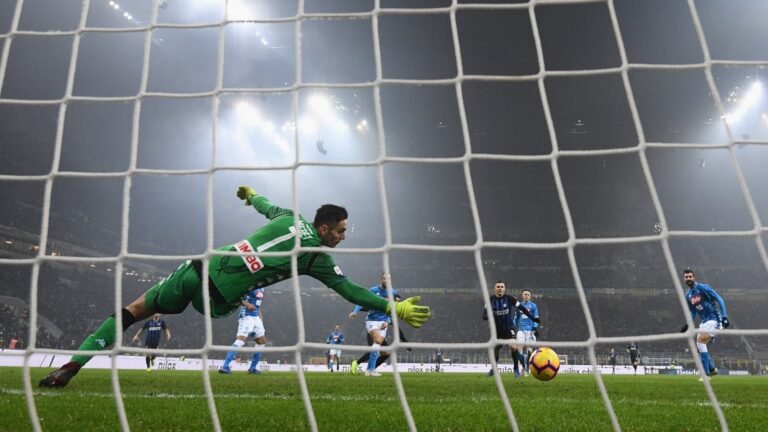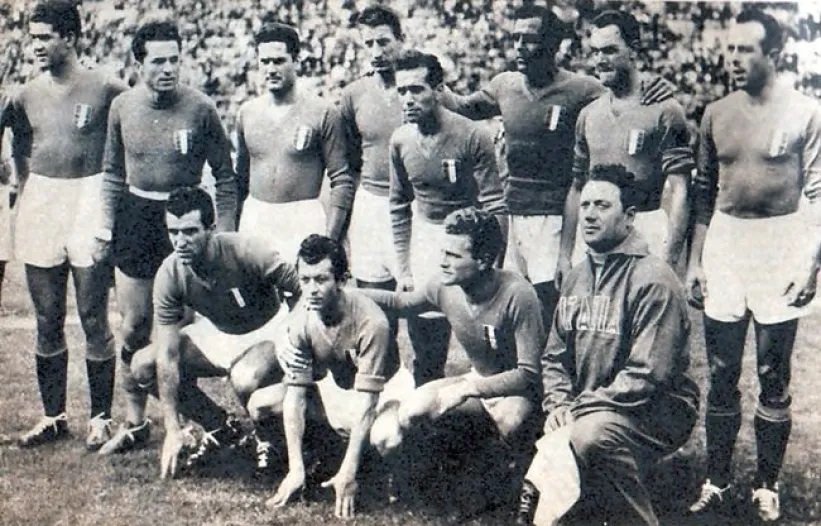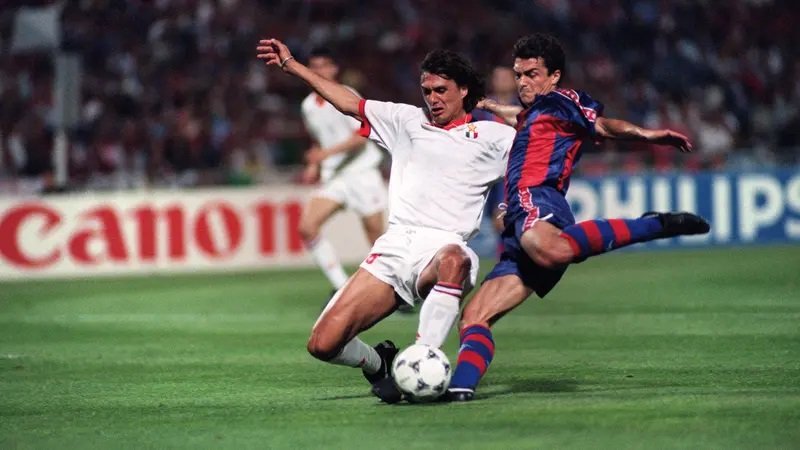- Last Updated -
A Glimpse into Italy of the 90s: Culture, Politics, and Soccer
in this article, we will look at the Golden Era of Italian Soccer.
As the 20th century began to wind down, Italy was a nation caught in a fascinating juxtaposition of tradition and modernity. The country had stepped boldly into democracy after parting ways with its tumultuous political past.
This transition was accompanied by an economic boom that saw Italy become one of Europe’s major players. Vibrant cities flourished against an enchanting backdrop of timeless architecture and landscapes painted in hues of history.
However, this period wasn’t merely about socio-political transitions; it was an era that changed the very fabric of Italian culture. The world fell in love with Italian fashion as Giorgio Armani, Versace, and Prada became household names.
Cinema enthusiasts were captivated by Tornatore’s masterpieces while Italian literature found a global voice through writers like Umberto Eco. Amidst this cultural revolution was another phenomenon – calcio (soccer), which became more than just a sport; it mirrored society’s pulse.
The 90s saw soccer take center stage in Italian life when stars transcended their roles as mere athletes to become cultural icons. This was when soccer conversations filled dinner tables and when Sunday evenings were reserved for ‘partita del cuore’ – the match of the heart.

The Golden Era: A Decade That Shaped Italian Soccer
The 1990s will forever hold a special place within the annals of Italian soccer history. Labeled as Serie A’s ‘Golden Era’, this decade witnessed some of the most riveting moments that soccer could offer – from breathtaking goals to heart-stopping matches – played out by teams boasting rosters overflowing with world-class talent. The allure lay not only in domestic victories but also on international platforms where clubs like AC Milan and Juventus held aloft Europe’s most coveted trophies while proudly draped in their nation’s tricolor flag.
Homegrown talents rubbed shoulders with foreign maestros resulting in teams that were not just collections of skilled individuals but true symphonies on grass. Football pundits often reminisce about this epoch, describing it as an era where each game held potential for poetry or drama – or both!
But what truly made these years golden was how they forged legends who transcended time, their tales echoing even today within passionate debates among calcio aficionados around who is ‘the greatest’. As we delve deeper into these magnificent times, let us journey together through league games lit up by dazzling skill shows, Champions League nights under star-studded skies, and World Cup spectacles etched forever in our hearts

The Teams That Dominated the Decade
AC Milan’s Dream Team: The Invincibles of Early 90s
When discussing Italian football in the 90s, it’s impossible to overlook AC Milan’s dominance in the early part of the decade. Under Arrigo Sacchi and later Fabio Capello, ‘I Rossoneri’ assembled a virtually invincible team.
They boasted stalwarts like Franco Baresi, Paolo Maldini, and Alessandro Costacurta in defense, while Ruud Gullit, Frank Rijkaard, and Marco van Basten provided firepower upfront. AC Milan played with an alluring blend of aggression and artistry that was a joy to behold.
Their crowning achievement came in 1994 when they annihilated Johan Cruyff’s Barcelona dream team 4-0 in the Champions League final. That performance serves as an enduring testament to this team’s potency.
Their domestic success was equally impressive with four Serie A titles, solidifying their status as one of the greatest club sides ever. However, like all good things inevitably do, this golden period at San Siro eventually faded but not before leaving an indelible mark on football history.
Juventus’ Rise to Power: How the Old Lady Conquered Europe
While AC Milan reigned supreme early on, Juventus or ‘La Vecchia Signora’ gradually emerged as a force to reckon with under Marcello Lippi’s astute guidance. The Turin giants assembled a formidable lineup featuring stars like Roberto Baggio, Gianluca Vialli, and later Alessandro Del Piero and Zinedine Zidane. In 1996 Juventus clinched their second European Cup by defeating reigning champions Ajax Amsterdam via penalties.
This monumental victory reaffirmed Juve’s status as European heavyweights after nearly two decades since their last European triumph. Dominating domestically as well during this era; Juventus captured four Serie A titles between 1995 and 2000 – setting a new standard for excellence even amidst fierce competition from other Italian powerhouses.
Inter Milan’s Struggles and Triumphs: A Rollercoaster Ride
In contrast to their cross-town rivals AC Milan’s shining dominance in the early years of the ’90s or Juventus’ gradual rise into power; Inter had quite a tumultuous decade with its fair share of struggles sprinkled with occasional triumphs. Despite having world-class talents such as German striker Klinsmann or Uruguayan wizard Ruben Sosa; Inter couldn’t match up to its domestic competitors during the majority part of this decade. The introduction of Brazilian phenomenon Ronaldo “Il Fenomeno” provided a brief respite for Nerazzurri followers.
His mesmerizing performances propelling Inter back into conversations about Italian soccer elite before injuries sadly curtailed his impact. Their crowning glory came towards the close decade when they clinched the UEFA Cup title in 1998 defeating Lazio – giving them something to cherish amidst the rollercoaster ride the decade had been for them.< / p >< h3 >The Underdogs who Shook Things Up Sampdoria, Parma, and Lazio
< p > In Italy’s ultra-competitive football landscape, smaller giants also emerged challenge hegemony established powers. Sampdoria led by mercurial talent Roberto Mancini along with able partner Gianluca Vialli proved to be the thorn side of many traditional big clubs.
Their crowning achievement undoubtedly being capturing Scudetto 1991 first time in club history .< / p >< p > Equally impressive was Parma who assembly of talented players such as Fabio Cannavaro, Gianfranco Zola Thomas Brolin led them winning the UEFA Cup twice becoming a perennial threat domestic league.< / p >
< p >In the latter part nineties, the capital city’s lesser-known club Lazio stirred a storm under coach Sergio Cragnotti ’ s reign. Having talents such as Pavel Nedved Marcelo Salas ranks helped them secure the Coppa Italia title and UEFA Winners ’ Cup paving the way for their incredible Scudetto victory the following year.

Legendary Players Who Defined an Era
The Magic Touch of Roberto Baggio: Cementing the Divine Ponytail’s Legacy
Let us commence this evocative journey with the illustrious Roberto Baggio, famously dubbed ‘The Divine Ponytail’. A player whose flamboyant style and captivating skills were matched only by his distinctive coiffure.
With a touch as soft as a butterfly’s wing and precision that would make a Swiss watchmaker envious, Baggio was poetry in motion on the field. Baggio’s mesmerizing free-kicks and nonchalant penalty kicks would often leave goalkeepers rooted to their spot, spectators agog, and commentators running out of superlatives.
His performance in the 1994 World Cup was particularly memorable with his five goals propelling Italy to the finals. Despite his infamous missed penalty kick, his legacy remains untarnished; Baggio will forever be remembered as one of soccer’s most graceful playmakers.
The career spanned over two decades bore witness to Baggio’s extraordinary talent, indomitable spirit, and undefeatable passion for the game. From Vicenza to Milan to Bologna – no matter where he played – The Divine Ponytail made an indelible mark on Italian Soccer in the ’90s.
Franco Baresi & Paolo Maldini: Constructing AC Milan’s Impenetrable Defensive Wall
In contrast to Baggio’s attacking prowess stands Franco Baresi – a defensive titan whose name became synonymous with AC Milan during this golden era. As captain of AC Milan for 15 years, his fortitude seemed as immovable as Mount Everest.
Baresi’s acumen in reading the game rendered him almost clairvoyant – always being at the right place at just the right time. His unparalleled anticipation skill made him an irresistible force on defense that brushed aside forwards like specks of dust from a priceless artifact.
Beside him stood another stalwart defender – Paolo Maldini. A one-club man who emanated loyalty so profound it mirrored ancient samurai codes of honor.
The sonorous thud echoing around San Siro when Maldini tackled opponents served as a testament to his unwavering commitment towards defending not just his goal but also his beloved club’s honor. Baresi and Maldini formed an impregnable defensive wall at AC Milan – an enduring testament to their mettle and immeasurable contribution towards shaping Italian Soccer in the 90s.
Alessandro Del Piero & Gianluigi Buffon: Personifying Juventus’ Iconic Status
Over at Juventus during this golden epoch were two players who would go on to etch their names into soccer folklore – Alessandro Del Piero and Gianluigi Buffon. Del Piero illuminated pitch after pitch with dazzling footwork that sent defenders into dizzying spins while fans marveled at this master craftsman at work.
His finesse was exemplified through snaking runs past bewildered defenders or beautifully curled free kicks that nestled softly into net corners like lullabies soothing infants into sleep. In stark contrast but no less important was Buffon’s towering presence between Juventus’ goalposts – An unyielding fortress guarding its treasure against plunderers with cat-like agility and reactions faster than lightning strikes.
Buffon had not only mastered artistry in goalkeeping but also brought along leadership qualities that transformed him into Juventus’ living talisman; A beacon guiding them through stormy encounters with unyielding determination etched onto every fiber of his being. Del Piero’s mesmerizing artistry combined with Buffon’s formidable presence forged Juventus into one of Europe’s top teams during this golden era – both players embodying what truly defines iconic status within Italian Soccer.

Iconic Matches That Shaped History
The Symphony of Soccer: 1994 Champions League Final – AC Milan vs Barcelona
The 1994 UEFA Champions League final is etched in the annals of football history as the night AC Milan produced one of its greatest-ever performances. Going up against Johan Cruyff’s ‘Dream Team’ Barcelona, the Rossoneri did not merely win; they romped to victory with a scintillating 4-0 scoreline.
Despite missing key players like Franco Baresi and Alessandro Costacurta, Fabio Capello’s side played with an infectious verve and cohesion that left Barca on their knees. Danish dynamo Brian Laudrup opened the scoring, ghosting past a static Barca defense to slot home a cool finish.
The Marauding Marcel Desailly hit a brace while Dejan Savićević provided an audacious lob over Andoni Zubizarreta. Each strike was as beautiful as it was symbolic; Milan was not just overcoming Barcelona, they were dismantling them.
That night in Athens wasn’t just about who lifted the trophy but rather served as proof of Italian soccer’s ascendancy in Europe. It encapsulated all that was admirable about Italian soccer prowess during this golden era – strategic brilliance fused with individual virtuosity and a relentless will to win.
A Tale of Two Cities: 1995 UEFA Cup Final – Parma vs Juventus
In May 1995, two Italian teams locked horns in an all-Italian UEFA Cup final for the first time. Juventus came into this contest as favorites given their domestic superiority, but Parma had been carving out quite a reputation on both domestic and European fronts.
The first leg ended in stalemate—a cagey affair offering only glimpses of what both teams could do when unshackled. Nevertheless, it set up an intriguing return fixture where Parma defied the odds by beating La Vecchia Signora 1-0 courtesy of Dino Baggio’s thunderous strike—unrelated to Roberto Baggio but equally magical on that day.
This final highlighted more than just Parma’s underdog story—it showcased the strength in depth within Italian football at that time. No other nation has since matched Italy’s feat from that year—four out of four finalists across UEFA’s top two club competitions being from one country.
Intense Rivalries Revisited: Serie A Showdowns – Inter vs Juve, Milan Derby Highlights
‘Derby della Madonnina’, or simply known as ‘The Milan Derby’, remains one of football’s most historic fixtures dating back to 1908. However, it reached new heights during Italy’s golden decade—the ’90s saw AC and Inter Milan tussle for supremacy amidst a backdrop filled with larger-than-life personalities such as coaches Fabio Capello and Giovanni Trapattoni; stars like Roberto Baggio and Lothar Matthäus.
Each meeting offered drama—a blend of sublime skills peppered with unruly tackles defined these games’ narrative arc where bragging rights often outweighed points at stake. One unforgettable episode was Mauro Tassotti elbowing Luis Enrique during their dying moments—events which sparked outrage across both camps further fuelling this fiery rivalry.
Meanwhile, another captivating series unfolded between Juventus and Inter—’Derby d’Italia’. The matches were mouth-watering contests full of twists & turns—an indomitable Juve squad led by Alessandro Del Piero clashing against Ronaldo-led Inter became regular weekend blockbuster material for any soccer connoisseur throughout the late ‘90s which further cemented Serie A’s global appeal.

The Influence of Tactical Innovations: The Showstoppers Behind the Spectacle
The Catenaccio System: Italian Defensive Masterclass
In the intricate ballet of soccer, none perhaps characterizes Italy’s style more than the art of defense. The 90s saw the peak of Italian soccer’s famed Catenaccio system.
This tactical approach, which loosely translates to “door bolt” or “lock,” represented a defensive masterclass that became synonymous with the Serie A. Designed for maximum safety first, it incorporated an additional defender, known as the ‘libero’ or ‘sweeper,’ into traditional formations to thwart any potential offensive threats. AC Milan’s legendary coach Arrigo Sacchi beautifully refined this system.
With players like Franco Baresi and Paolo Maldini leading his backline, Sacchi adopted a zonal marking strategy instead of traditional man-marking. The defensive lines held tight with impeccable synchronization and precise movements that rendered opposing offenses futile.
This strategy brought AC Milan unprecedented success in Europe and domestically during this period. It also heavily influenced other teams in Serie A, solidifying Italy’s reputation for producing robust defenses and tactically astute defenders—reverberation felt even today.
The Rise of Trequartista Role: Playmaking Redefined
While Italy’s Catenaccio popularized robust defense systems worldwide, its contribution to redefining playmaking can’t be overlooked either – enter the Trequartista. This role is an inherently Italian concept designating a player who operates behind strikers – part conductor, part magician – tasked with both creating scoring opportunities and finding the net themselves. In 90s Italian football, no one embodied this role better than Roberto Baggio – fondly known as Il Divin Codino (The Divine Ponytail).
With his remarkable vision for exploiting spaces and extraordinary dribbling abilities coupled with an uncanny knack for scoring spectacular goals, Baggio was sensational to watch! His performances were instrumental in both Juventus’ domestic dominance and their strong presence on the European stage during that era.
The Trequartista became a vital cog in Italian teams’ machinery during this golden era contributing significantly to their exciting gameplay dynamics. It led to unprecedented fan interest worldwide while inspiring generations of young footballers who dreamt of emulating their heroes’ wizardry on-field-thus etching indelible marks on soccer’s evolution overall.
Azzurri’s Dance on the Global Stage: International Successes
The 1994 World Cup: The Unfulfilled American Dream
In 1994, Italy went to the United States with hopes as high as skyscrapers. The team was brimming with talent, featuring stars like Roberto Baggio, Franco Baresi, and Paolo Maldini.
The Azzurri showed their mettle by progressing through to the final after a rocky start in the group stage. Baggio’s brilliance shone brightly during this campaign; his performances against Nigeria and Spain were particularly mesmerizing.
However, when it came down to the final match-up against Brazil at Pasadena’s Rose Bowl Stadium, Lady Luck seemed to abandon our beloved Azzurri. After a nail-biting goalless draw led to penalties, Roberto Baggio – Italy’s hero throughout the competition – was tragically fired over in what would become one of the most unforgettable moments of Italian soccer.
Regardless of this heart-wrenching defeat, Italy’s run in USA ’94 left an indelible mark on world football. Despite falling at the very last hurdle, they had shown incredible fortitude and resilience throughout their journey in America – qualities that would continue to define Italian soccer.
Euro ’96 & France ’98: Lofty Aspirations and Lessons Learned
The mid-to-late 90s brought more opportunities for international glory for Italy. However, both Euro ’96 and World Cup ’98 resulted in bittersweet experiences for Azzurri followers worldwide.
Euro ’96 hosted by England started auspiciously enough for Italy as they bested Russia thanks to goals from Casiraghi and Di Matteo. However subsequent encounters proved less fruitful; a surprising loss to the Czech Republic followed by a stalemate against an underdog German side saw our heroes bow out prematurely at group stage.
Two years later though, Les Bleus welcomed world football with open arms as France hosted the 1998 World Cup. This time around there was no room for complacency as coach Cesare Maldini assembled a formidable squad that included Alessandro Del Piero and Christian Vieri alongside veterans like Paolo Maldini and Fabio Cannavaro.
Italy possessed all requisite ingredients for success but alas! fortune proved adversarial yet again during their quarter-final encounter against hosts France.
A thrilling match ended all square after extra time leading to an agonizing penalty shoot-out where Luigi Di Biagio’s miss consigned Italians once more into a world of disappointment. Bitter as these tournaments may have been for Italian fans, they provided instrumental lessons contributing towards future triumphs of Italian Soccer on international stages.

When Calcio Captivated the World: The Cultural Impact of Italian Soccer
The 1990s were an epoch where Italian soccer transcended the boundary of sport and became an integral part of global pop culture. This was facilitated by a deluge of international superstars such as George Weah, Gabriel Batistuta, and Ronaldo adorning Serie A. Their flamboyant playing styles, coupled with unique personal charisma, attracted legions of fans from all corners of the globe.
More than just a game, soccer in Italy has always been intertwined with the societal fabric. The drama unfolding on the pitch often mirrored complex socio-political narratives off it.
Stadia were vibrant tapestries showcasing regional pride and identity; games were high-stakes microcosms reflecting national hopes and anxieties. The halcyon days of calcio also helped to shape Italy’s image abroad.
The country was no longer seen merely as a repository of Renaissance art or gastronomic delights but as a powerhouse in sports too – specifically soccer. It amplified Italy’s soft power projection worldwide and immeasurably added to its cultural cachet.
A Game Unforgotten: Reflecting on An Era Par Excellence
Few eras in football history hold such enchanting allure as the Golden Age of Italian Soccer in the 1990s. It brimmed with unforgettable teams that created timeless memories and players who became lodestars for future generations to emulate. Surely enough, calcio has evolved since then — new heroes have emerged; old rivalries have intensified further; fortunes have fluctuated — but its golden era continues to retain an ethereal charm that is uniquely it’s own.
We can’t predict what tomorrow will bring for this beautiful game in Italy. But one thing is certain – if it’s anything close to those glorious years we’ve walked down memory lane today – fans are in for an absolute treat!
Quick Take Aways of
The Golden Era of Italian Soccer in the 1990s
The 1990s is indeed considered a golden era for Italian soccer, with Serie A being one of the most competitive and popular leagues in the world at the time.
AC Milan was a dominant force in the early part of the decade, with players like Franco Baresi, Paolo Maldini, and Alessandro Costacurta in defense, and Ruud Gullit, Frank Rijkaard, and Marco van Basten in the attack. The team’s crowning achievement was indeed their 4-0 victory over Barcelona in the 1994 Champions League final.
Juventus also emerged as a strong team during this period, with players like Roberto Baggio, Gianluca Vialli, Alessandro Del Piero, and Zinedine Zidane. They won the European Cup in 1996 by defeating Ajax Amsterdam.
Inter Milan had a more tumultuous decade, with some successes but also struggles. The arrival of Brazilian player Ronaldo did provide a boost for the team.
Smaller teams like Sampdoria, Parma, and Lazio also had their moments of glory during this period.
Roberto Baggio, Franco Baresi, Paolo Maldini, Alessandro Del Piero, and Gianluigi Buffon were indeed key figures in Italian soccer during the 1990s.
The 1994 World Cup was a significant event for Italy, with the team reaching the final but ultimately losing to Brazil in a penalty shootout.
The tactical innovations of the Catenaccio system and the Trequartista role were indeed influential during this period.
Italian soccer in the 1990s had a significant cultural impact, with the league attracting international superstars and gaining a global fanbase.
The Changing Role of Wingers in Soccer
The Changing Role of Wingers in Soccer. Soccer has captivated millions around...
Read MoreConcussion Substitutions in Soccer: evolving concussion protocols
The Growing Concern for Player Safety in Soccer Soccer, a beloved sport...
Read MoreBest Indoor Soccer Shoes 2024
Indoor soccer has been gaining popularity over the years, with more and...
Read More5 Best Soccer Cleats For Speed In 2024
Our Top 5 Picks for the Best Soccer Cleats for Speed in...
Read MoreBest Soccer Cleats For Defenders 2024
What are the Best Soccer Cleats for Defenders? In our opinion, the...
Read MoreSoccer Goalie Rules: Understanding the Goalkeeper Position
As soccer players try to gain control of the game, midfielders are...
Read MoreWhat is a cap in soccer?
If you're a soccer fan, you've probably heard the term "cap" being...
Read MoreHow To Be A Good Soccer Parent! A Guide to Sideline Etiquette
What Makes A Good Soccer Parent? As a soccer parent, you have...
Read MoreSoccer Referee Roles and Responsibilities
The Crucial Role of a Soccer Referee In the vast realm of...
Read MoreBest Laceless Soccer Cleats 2024
What Are The Best Laceless Soccer Cleats? Soccer players know the importance...
Read MoreSoccer Corner Kick – Soccer Law #17
A corner kick is a type of free-kick that is awarded to...
Read MoreBest Soccer Cleats For Midfielders 2024
The Best Soccer Cleats For Midfielders in 2023 - Our Top 5...
Read MoreBest Soccer Cleats for Flat Feet 2024
Unlock your soccer potential and tap into the game-changing secret: the ultimate...
Read MoreUnderstanding the Offside Rule in Soccer
Soccer, also known as football, is one of the most popular sports...
Read MoreBest Soccer Cleats for Women In 2024: Top 5 Picks
The Best Soccer Cleats for Women in 2023: Top 5 Picks The...
Read MoreVersatile Soccer Players: Chameleons of the Pitch
Ah, the beautiful game of soccer! A sport that has captivated millions...
Read MoreSoccer Goal Size and Dimensions
Brief History of Soccer Soccer has been played in various forms throughout...
Read MoreBest Goalkeeper Gloves 2024
What are the best goalkeeper gloves? When it comes to soccer equipment,...
Read MoreAn Introduction and History of UEFA Champions League
In terms of prestige, nothing surpasses lifting ‘the cup with big ears’,...
Read More5-3-2 Soccer Formation: History and Tactics
Are you a soccer enthusiast looking to understand the tactical intricacies that...
Read More5 Best Soccer Cleats For Strikers in 2024
What are the Best Soccer Cleats for Strikers? The beautiful game of...
Read MoreDo Grip Socks Help In Soccer?
Do Grip Socks Help In Soccer? The Importance of Footwear in Soccer...
Read MoreSoccer History USA: From Struggles to Successes
Soccer, also known as football, is the world's most popular sport, with...
Read MoreBest Soccer Ball For Games in 2024: Top 5 Picks
The Importance of Having a Good Soccer Ball for Training Soccer requires...
Read MoreBox-to-Box Center Midfielder: The Engine of Modern Soccer Teams
Soccer is a game of skill, strategy, and teamwork. Every player has...
Read MoreThe Mercy Rule In Soccer And The Roll It Plays
Picture this: a soccer match, with one team dominating the field and...
Read Moresoccer position numbers quick guide
Each player on the field has an important job as it relates...
Read MoreThe Historical Dominance of Brazilian Soccer in the World Cup
Introduction: The Beautiful Game's Grandest Stage The World Cup, a grand tournament...
Read MoreWhat is a Set Piece in Soccer?
What is a set piece in soccer? Introduction Soccer is a sport...
Read MoreChoosing the Right Soccer Ball Size by Age
Soccer is undeniably one of the most popular sports in the world,...
Read MoreBest Youth Soccer Cleats for 2024 : Top 5 Pick
Welcome to our comprehensive guide on the best youth soccer cleats for...
Read MoreWhat is Soccer Relegation?
Introduction: Exploring the World of Soccer relegation Soccer is one of the...
Read MoreWhat is a Soccer Assist?
The Importance of Teamwork in Soccer The importance of teamwork in soccer...
Read MoreSoccer Overtime Rules: Everything You Need to Know
Introduction: Overtime Soccer Rules Everything You Need To Know Soccer is a...
Read MoreSoccer Substitution Rules: The Strategic Art of Changing the Game
Soccer, known as the beautiful game worldwide, has seen various changes to...
Read MoreHow Many Soccer Games In A Season
The number of soccer games in a season varies depending on the...
Read MoreBest Soccer Ball for Training: Top 5 Picks
The Importance of Having a Good Soccer Ball for Training Soccer requires...
Read MoreTwo Soccer Skills That Are Essential
Shooting and Heading the soccer ball are both soccer skills you should...
Read MoreSoccer Throw In Rules – Soccer Law #15
Law Number 15 - Throw Ins A throw-in in soccer is granted...
Read More





































